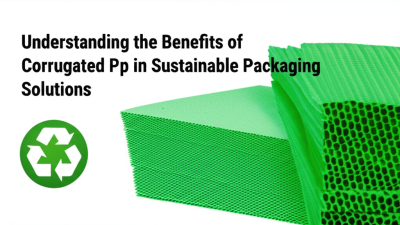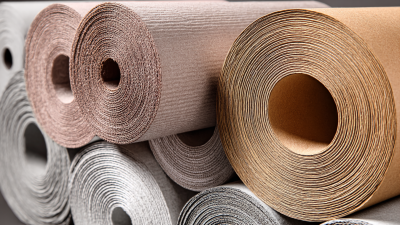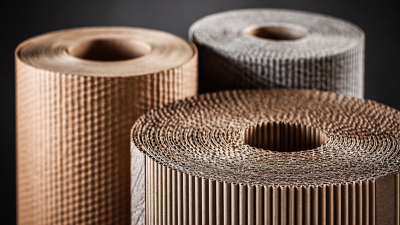
- export5@runpingpp.com
- 24 Hours Online



Industry News
Understanding the Benefits of Corrugated Pp in Sustainable Packaging Solutions
In recent years, the demand for sustainable packaging solutions has surged, driven by both consumer preference and regulatory pressures for environmentally friendly practices. Among various materials, Corrugated PP (Polypropylene) has emerged as a frontrunner due to its lightweight, durability, and recyclability. According to a recent report by Smithers Pira, the global market for sustainable packaging is projected to reach $500 billion by 2027, with flexible packaging, including Corrugated PP, expected to play a significant role in this growth, achieving a compound annual growth rate (CAGR) of 4.3%.

This innovative material not only reduces environmental impact by minimizing waste but also offers superior protection for goods during transit. By exploring the benefits of Corrugated PP in sustainable packaging solutions, companies can enhance their brand image while contributing to a more sustainable future.
The Role of Corrugated PP in Reducing Carbon Footprint in Packaging
Corrugated polypropylene (PP) is emerging as a key player in sustainable packaging solutions, primarily due to its ability to significantly reduce carbon footprints associated with packaging. By utilizing lightweight and durable materials, manufacturers can decrease transportation emissions and energy consumption. Reports indicate that shifting to corrugated PP can enhance recycling rates, with traditional materials seeing as much as a 70% increase in recoverability when replaced with corrugated options. This shift aligns with industry efforts to minimize reliance on virgin plastics and adopt circular economy principles.
Tips: When considering sustainable packaging options, prioritize materials that offer recyclability and reduced weight. Assess your supply chain to identify areas where packaging waste can be minimized.
Additionally, companies are increasingly recognizing the importance of right-sizing their packaging to further decrease carbon emissions and waste. According to recent data, optimizing package sizes can reduce material use by up to 30%, significantly lowering overall carbon footprints. As consumer demand for eco-friendly options rises, corrugated PP stands out as a particularly efficient choice for brands committed to sustainability.
Tips: Implement right-sizing strategies to cut costs and decrease your environmental impact simultaneously. Continuously evaluate your packaging materials for recyclability and overall sustainability.
Market Growth: Corrugated PP’s Share in the Sustainable Packaging Industry
The corrugated polypropylene (PP) packaging market is experiencing notable growth as sustainability becomes a focal point for businesses and consumers alike. Projected to grow from USD 12.6 billion in 2025 to USD 22.1 billion by 2035, the polypropylene corrugated packaging segment is gaining traction for its lightweight, durable, and recyclable qualities. Increasing demand for sustainable packaging solutions has positioned corrugated PP as a favorable option for various industries, helping to reduce environmental impact while maintaining product integrity.
In parallel, the U.S. corrugated plastic sheets market, which was estimated at USD 177.9 million in 2024, is anticipated to reach USD 277.3 million by 2033, reflecting a robust CAGR. This growth illustrates the expanding role of corrugated materials in packaging, particularly as brands seek to enhance their sustainability profiles and cater to environmentally conscious consumers. Such trends underline the growing importance of corrugated PP in the sustainable packaging landscape, highlighting both market potential and the shifting preferences toward more eco-friendly packaging solutions.
Comparative Analysis: Costs of Corrugated PP vs. Traditional Packaging Materials
The comparative analysis of the costs between corrugated polypropylene (PP) and traditional packaging materials reveals significant advantages for businesses looking to adopt sustainable solutions. Corrugated PP stands out with its lightweight nature, which not only reduces shipping costs but also minimizes the carbon footprint associated with transportation. Additionally, the durability of corrugated PP provides enhanced protection for products, reducing the need for additional packaging layers and thus lowering overall packaging expenses.
Traditional packaging materials often entail higher production and disposal costs, as their manufacturing processes can be energy-intensive and reliant on non-renewable resources. In contrast, the investment in corrugated PP, although sometimes higher upfront, can lead to long-term savings through its recyclability and resistance to damage. Companies employing corrugated PP can benefit from streamlined operations and reduced waste, making it a more appealing option in an increasingly eco-conscious market. The flexibility in design and ease of production further make corrugated PP a compelling alternative, especially when considering the evolving needs of sustainable packaging practices.
Case Studies: Successful Implementation of Corrugated PP in Various Industries
The implementation of corrugated polypropylene (PP) in various industries has showcased its versatility and sustainability. For instance, a prominent food packaging company adopted corrugated PP containers for fresh produce. The lightweight yet sturdy design significantly reduced transportation costs and extended shelf life due to its moisture-resistant properties. This shift not only minimized food waste but also improved overall customer satisfaction, demonstrating how innovative materials can drive better business outcomes while being environmentally friendly.
In the electronics sector, a leading manufacturer transitioned to corrugated PP for shipping their high-value products. This new packaging solution provided superior protection against impact and moisture compared to traditional materials. The adoption of corrugated PP resulted in a streamlined supply chain, with reductions in damage rates and lower packaging volume leading to increased efficiency. Such case studies illustrate that corrugated PP is not only a sustainable alternative but also enhances operational performance across diverse industries.
Understanding the Benefits of Corrugated PP in Sustainable Packaging Solutions
This chart illustrates the benefits of using corrugated polypropylene (PP) in various industries as part of sustainable packaging solutions. The data showcases the percentage of companies that reported improvements in key sustainability metrics after implementing corrugated PP packaging.
Innovations in Design: Enhancing Functionality and Sustainability of Corrugated PP Packaging
The innovations in design of corrugated polypropylene (PP) packaging are transforming the landscape of sustainable packaging solutions. As industry standards evolve, companies are increasingly recognizing the potential of corrugated PP to enhance both functionality and sustainability. According to a recent report by Smithers Pira, the global market for sustainable packaging is expected to reach $500 billion by 2027, driven largely by consumer demand for eco-friendly materials. Corrugated PP, with its lightweight yet durable qualities, aligns perfectly with this trend, offering a solution that reduces material waste while maintaining structural integrity.
Moreover, advancements in manufacturing techniques have allowed for the development of custom designs that cater to various logistical challenges. The flexibility of corrugated PP enables innovations such as modular packaging systems that can be easily assembled, disassembled, and reused, minimizing environmental impact. The European Commission has reported that enhanced recyclability of materials like corrugated PP can lead to a reduction in greenhouse gas emissions by up to 30%. As businesses continue to prioritize sustainability, embracing the innovative design options available in corrugated PP packaging will be essential for meeting both consumer expectations and regulatory demands.
Related Posts
-

Future Market Insights and Trends for Best Corrugated PP by 2025 in the Packaging Industry
-

Ultimate Checklist for Choosing the Best Corrugated PP Products for Your Business Needs
-

Understanding the Benefits of Pp Corrugated for Sustainable Packaging Solutions
-

Mastering the Use of Corrugated Plastic Totes for Efficient Warehouse Management
-

What is a Pp Corrugated Plastic Box and Why is it Your Best Packaging Solution?
-

Crafted with Precision Premium Corrugated Plastic Box Manufacturing for Global Supply Chain Excellence